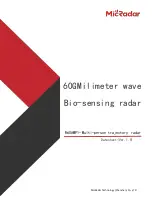
SM SYGNUS SHC USER´S MANUAL
17
Select the Best Location
Select the appropriate locations for the outdoor unit using the following guidelines:
• The outdoor unit can be pole or wall mounted.
• The location should allow easy access to the unit for installation.
• When using an external antenna, the unit should be installed as near as possible to the antenna.
• Make sure clear Line of Sight between the units.
Path of Clearest Propagation
A propagation path is the path that signals traverse between the antennas of any two bridges. The
“line” between two antenna sites is an imaginary straight line, which may be drawn between the two
antennas. Any obstacles in the path of the “line” degrade the propagation path. The best propagation
path is, therefore, a clear line of sight with good clearance between the “line” and any physical
obstacle.
Physical Obstacles
Any physical object in the path between MU and SU can cause signal attenuation. Common
obstructions are buildings, trees and hills located in the path between the two sites. Install outdoor
antennas high enough to avoid any obstacles, which may block the signal.
Minimal Path Loss
Path loss is determined by several factors:
• Distance between sites – Path loss is lower when distances between sites are shorter.
• Clearance – Path loss is minimized when there is a clear line of sight. The number, location, and
size of obstacles determine their contribution to path loss.
• Antenna height – Path loss is lower when antennas are positioned higher.
• Antenna height is the distance from the imaginary line connecting the antennas at the two sites to
“ground” level. “Ground” level in an open area is the actual ground. In dense urban areas,
“ground” level is the average height of the buildings between the antenna sites.















































